Bài viết này sẽ giúp người học nắm rõ cách xác định từ khóa, vị trí thông tin và phân tích đáp án cho đề Cambridge IELTS 16, Test 1, Reading Passage 1: Why We Need to Protect Polar Bears. Cùng ELSA Speak khám phá những kỹ năng cần thiết để chinh phục bài thi IELTS Reading nhé!
Hướng dẫn chung cách làm bài IELTS Reading
Để đạt kết quả cao trong phần thi IELTS Reading, nắm vững kỹ thuật và cách làm bài là yếu tố vô cùng quan trọng. Dưới đây là các bước hướng dẫn cụ thể, giúp bạn tự tin hơn khi làm bài.
Kiểm tra phát âm với bài tập sau:

- Đọc hướng dẫn để hiểu mỗi câu hỏi trước khi trả lời.
- Dành khoảng 20 phút cho mỗi đoạn văn.
- Lướt qua và tìm kiếm để nhanh chóng nắm bắt ý chính.
- Đánh dấu thông tin quan trọng bằng cách gạch dưới các từ hoặc cụm từ thiết yếu.
- Cố gắng trả lời mọi câu hỏi.
- Giữ tập trung, tránh phân tâm và giữ sự chú ý vào nhiệm vụ.
- Đảm bảo chính tả và ngữ pháp đúng.
- Viết câu trả lời gọn gàng trên tờ trả lời.
- Nếu bạn gặp khó khăn, hãy bỏ qua câu đó, tiếp tục với câu tiếp theo và quay lại sau nếu còn thời gian.
- Nếu có thời gian, hãy xem lại câu trả lời của bạn.
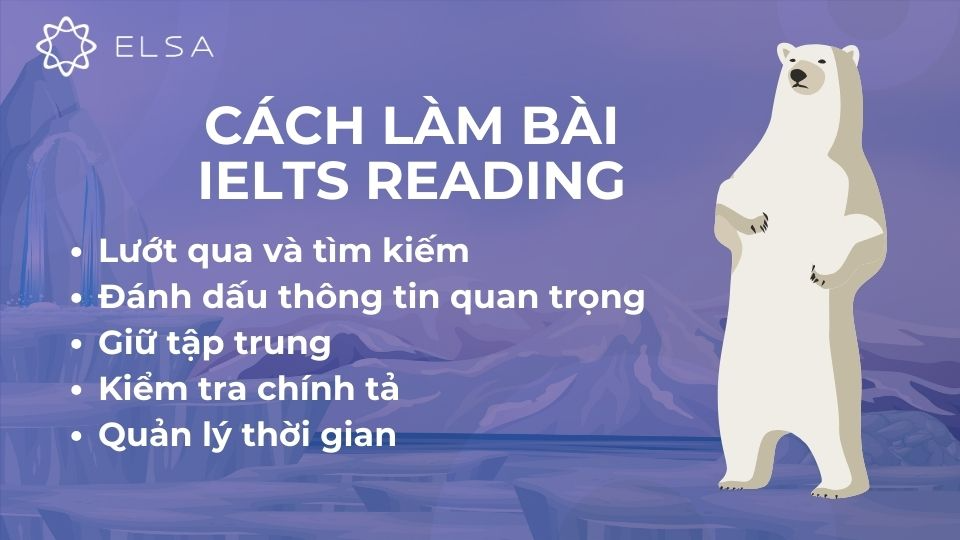
Bài Reading “Why We Need to Protect Polar Bears”
Polar bears are being increasingly threatened by the effects of climate change, but their disappearance could have far-reaching consequences. They are uniquely adapted to the extreme conditions of the Arctic Circle, where temperatures can reach -40°C. One reason for this is that they have up to 11 centimetres of fat underneath their skin. Humans with comparative levels of adipose tissue would be considered obese and would be likely to suffer from diabetes and heart disease. Yet the polar bear experiences no such consequences.
A 2014 study by Shi Ping Liu and colleagues sheds light on this mystery. They compared the genetic structure of polar bears with that of their closest relatives from a warmer climate, the brown bears. This allowed them to determine the genes that have allowed polar bears to survive in one of the toughest environments on Earth. Liu and his colleagues found the polar bears had a gene known as APOB, which reduces levels of low-density lipoproteins (LDLs) – a form of ‘bad’ cholesterol. In humans, mutations of this gene are associated with increased risk of heart disease. Polar bears may therefore be an important study model to understand heart disease in humans.
The genome of the polar bear may also provide the solution for another condition, one that particularly affects our older generation: osteoporosis. This is a disease where bones show reduced density, usually caused by insufficient exercise, reduced calcium intake or food starvation. Bone tissue is constantly being remodelled, meaning that bone is added or removed, depending on nutrient availability and the stress that the bone is under. Female polar bears, however, undergo extreme conditions during every pregnancy. Once autumn comes around, these females will dig maternity dens in the snow and will remain there throughout the winter, both before and after the birth of their cubs. This process results in about six months of fasting, where the female bears have to keep themselves and their cubs alive, depleting their own calcium and calorie reserves. Despite this, their bones remain strong and dense.
Physiologists Alanda Lennox and Allen Goodship found an explanation for this paradox in 2008. They discovered that pregnant bears were able to increase the density of their bones before they started to build their dens. In addition, six months later, when they finally emerged from the den with their cubs, there was no evidence of significant loss of bone density. Hibernating brown bears do not have this capacity and must therefore resort to major bone reformation in the following spring. If the mechanism of bone remodelling in polar bears can be understood, many bedridden humans, and even astronauts, could potentially benefit.
The medical benefits of the polar bear for humanity certainly have their importance in our conservation efforts, but these should not be the only factors taken into consideration. We tend to want to protect animals we think are intelligent and possess emotions, such as elephants and primates. Bears, on the other hand, seem to be perceived as stupid and in many cases violent. And yet anecdotal evidence from the field challenges those assumptions, suggesting for example that polar bears have good problem-solving abilities. A male bear called GoGo in Tennoji Zoo, Osaka, has even been observed making use of a tool to manipulate his environment. The bear used a tree branch on multiple occasions to dislodge a piece of meat hung out of his reach. Problem-solving ability has also been witnessed in wild polar bears, although not as obviously as with GoGo. A calculated move by a male bear involved running and jumping onto barrels in an attempt to get to a photographer standing on a platform four metres high.
In other studies, such as one by Alison Ames in 2008, polar bears showed deliberate and focussed manipulation. For example, Ames observed bears putting objects in piles and then knocking them over in what appeared to be a game. The study demonstrates that bears are capable of agile and thought-out behaviours. These examples suggest bears have greater creativity and problem-solving abilities than previously thought.
As for emotions, while the evidence is once again anecdotal, many bears have been seen to hit out at ice and snow – seemingly out of frustration – when they have just missed out on a kill. Moreover, polar bears can form unusual relationships with other species, including playing with the dogs used to pull sleds in the Arctic. Remarkably, one hand-raised polar bear called Agee has formed a close relationship with her owner Mark Dumas to the point where they even swim together. This is even more astonishing since polar bears are known to actively hunt humans in the wild.
If climate change were to lead to their extinction, this would mean not only the loss of potential breakthroughs in human medicine, but more importantly, the disappearance of an intelligent, majestic animal.
Dịch đoạn 1 bài Reading Why We Need to Protect Polar Bears:
| Tiếng Anh | Dịch tiếng Việt |
| Polar bears are being increasingly threatened by the effects of climate change, but their disappearance could have far-reaching consequences. They are uniquely adapted to the extreme conditions of the Arctic Circle, where temperatures can reach -40°C. One reason for this is that they have up to 11 centimetres of fat underneath their skin. Humans with comparative levels of adipose tissue would be considered obese and would be likely to suffer from diabetes and heart disease. Yet the polar bear experiences no such consequences. | Gấu Bắc Cực đang ngày càng bị đe dọa bởi những tác động của biến đổi khí hậu, nhưng sự biến mất của chúng có thể có những hệ quả to lớn. Chúng thích nghi một cách đặc biệt với những điều kiện khắc nghiệt của Bắc Cực, nơi mà nhiệt độ có thể tới -40 độ C. Một trong những lí do cho điều này là chúng có lớp mỡ dưới da lên đến 11 centimetres. Con người với những mức độ của mô mỡ như vậy sẽ được coi là béo phì và có thể phải chịu đựng những căn bệnh như tiểu đường và tim mạch. Tuy nhiên gấu bắc cực không trải qua những hệ quả như vậy. |
Từ vựng đoạn 1 bài Reading Why We Need to Protect Polar Bears:
| Từ vựng | Phiên âm | Dịch nghĩa |
| Threaten (v) | /ˈθret.ən/ | Hăm dọa, đe dọa |
| Threatened (adj) | /ˈθret.ənd/ | Trong tình thế nguy hiểm hoặc có khả năng kết thúc sự tồn tại |
| Far-reaching (adj) | /ˌfɑːˈriː.tʃɪŋ/ | Có một tính chất rộng lớn về phạm vi, chủng loại, tác động, hay hệ quả |
| Uniquely (adv) | /juːˈniːk.li/ | Không bình thường hoặc đặc biệt ở phương diện nào đó |
| Adapted (adj) | /əˈdæp.tɪd/ | Có khả năng tồn tại ở môi trường nhất định bởi những thay đổi xảy ra với nó qua nhiều năm |
| Extreme (adj) | /ɪkˈstriːm/ | Rất tồi tệ |
| Up to (adv) | /ʌp tuː/ | Dùng để nói cái gì đó ít hơn hoặc bằng nhưng không quá với giá trị, con số, mức độ được nêu |
| Comparative (adj) | /kəmˈpær.ə.tɪv/ | Dùng để nói rằng bạn đang đánh giá thứ gì đó với một thứ khác hay trước đó |
| Adipose tissue (n) | /ˈæd.ɪ.poʊs ˈtɪʃ.uː/ | Adipose: Relating to animal fat: Liên quan đến mỡ động vật. Adipose tissue = Fat: Mô mỡ |
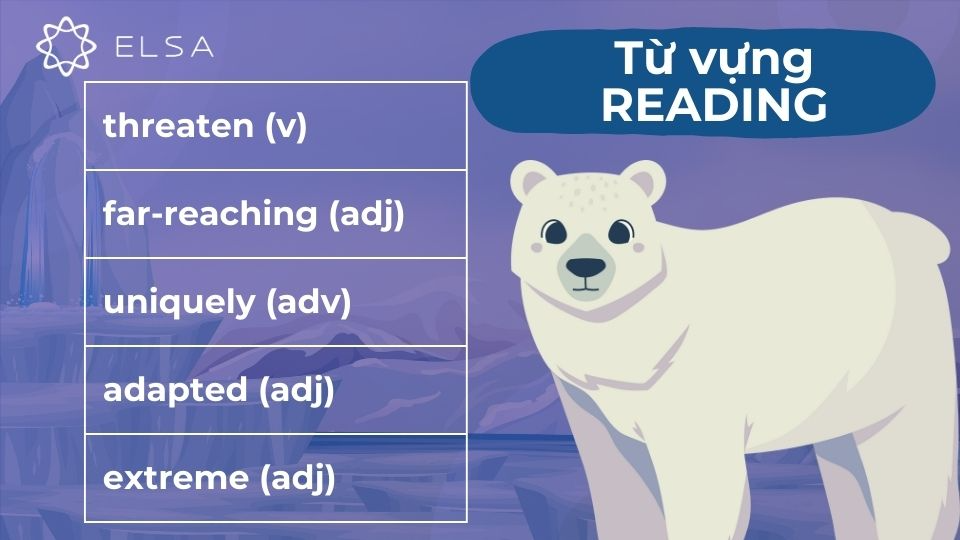
Có thể bạn quan tâm: Click vào banner dưới đây để luyện tập thường xuyên các từ vựng thường xuất hiện trong bài Why We Need to Protect Polar Bears cùng ELSA Speak nhé!

Dịch đoạn 2 bài Reading Why We Need to Protect Polar Bears:
| Tiếng Anh | Dịch tiếng Việt |
| A 2014 study by Shi Ping Liu and colleagues sheds light on this mystery. They compared the genetic structure of polar bears with that of their closest relatives from a warmer climate, the brown bears. This allowed them to determine the genes that have allowed polar bears to survive in one of the toughest environments on Earth. Liu and his colleagues found the polar bears had a gene known as APOB, which reduces levels of low-density lipoproteins (LDLs) – a form of ‘bad’ cholesterol. In humans, mutations of this gene are associated with increased risk of heart disease. Polar bears may therefore be an important study model to understand heart disease in humans. | Một nghiên cứu vào năm 2014 bởi Shi Ping Liu và đồng nghiệp làm sáng tỏ bí ẩn này. Họ đã so sánh cấu trúc gen của gấu Bắc cực với cấu trúc gen của những bà con gần gũi nhất của chúng từ một khí hậu ấm áp hơn, loài gấu nâu. Điều này đã giúp cho họ xác định những loại gen mà đã và đang cho phép các chú gấu Bắc cực tồn tại ở một trong những môi trường khắc nghiệt nhất trên trái đất. Liu và đồng nghiệp của ông ấy đã tìm ra gấu Bắc cực có một loại gen được biết là APoB, thứ mà giảm bớt các mức của lipoprotein mật độ thấp (LDLs) – một hình thái của cholesterol ‘xấu’. Ở con người, các biến đổi của loại gen này là liên đối với rủi ro cao của bệnh tim. Do vậy gấu Bắc Cực có lẽ là một hình mẫu nghiên cứu quan trọng để hiểu về bệnh tim ở con người. |
Từ vựng đoạn 2 bài Reading Why We Need to Protect Polar Bears:
| Từ vựng | Phiên âm | Dịch nghĩa |
| Shed light on sth (phr) | /ʃɛd laɪt ɒn sʌmθɪŋ/ | Cung cấp thông tin về cái gì hoặc làm cho cái gì đó dễ hiểu hơn |
| Relative (n) | /ˈrɛlətɪv/ | Một thành viên trong gia đình |
| Allow (v) | /əˈlaʊ/ | Làm cho việc gì đó có thể được hoàn thành hoặc xảy ra |
| Density (n) | /ˈdɛnsɪti/ | Mật độ |
| Mutation (n) | /mjuːˈteɪʃən/ | Sự thay đổi, sự biến đổi |
| Associated (adj) | /əˈsəʊʃieɪtɪd/ | Kết nối, liên quan |
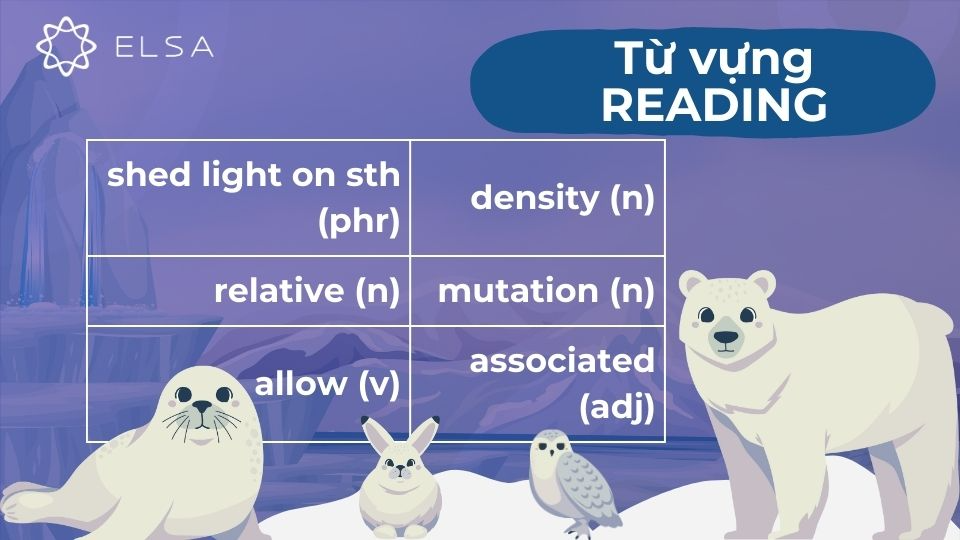
Dịch đoạn 3 bài Reading Why We Need to Protect Polar Bears:
| Tiếng Anh | Dịch tiếng Việt |
| The genome of the polar bear may also provide the solution for another condition, one that particularly affects our older generation: osteoporosis. This is a disease where bones show reduced density, usually caused by insufficient exercise, reduced calcium intake or food starvation. Bone tissue is constantly being remodelled, meaning that bone is added or removed, depending on nutrient availability and the stress that the bone is under. Female polar bears, however, undergo extreme conditions during every pregnancy. Once autumn comes around, these females will dig maternity dens in the snow and will remain there throughout the winter, both before and after the birth of their cubs. This process results in about six months of fasting, where the female bears have to keep themselves and their cubs alive, depleting their own calcium and calorie reserves. Despite this, their bones remain strong and dense. | Bộ gen của gấu Bắc cực có lẽ cũng có thể cung cấp giải pháp cho những tình trạng khác, một trong số đó đặc biệt ảnh hưởng đến thế hệ người già của chúng ta: bệnh loãng xương. Đây là một căn bệnh mà xương biểu lộ rằng đã bị giảm mật độ, thường được gây nên bởi thiếu vận động thể chất, sụt giảm lượng thu nạp canxi hay thiếu đói đồ ăn dài ngày. Mô xương liên tục được thay đổi về cấu trúc, nghĩa là xương được thêm vào hay mất đi, phụ thuộc vào dinh dưỡng sẵn có và sức ép mà xương phải gánh chịu. Tuy nhiên, gấu Bắc cực cái phải trải qua những điều kiện khắc nghiệt suốt mỗi thai kỳ. Mỗi khi mùa thu trở lại, những con cái này sẽ đào những cái hang ổ để sinh đẻ trong tuyết và sẽ ở đó trong suốt mùa đông, cả trước và sau khi sinh con của chúng. Quá trình này dẫn đến tình trạng nhịn ăn trong khoảng sáu tháng, nơi mà những con gấu Bắc Cực cái phải giữ gìn sự sống còn của chính chúng và những đứa con, tiêu giảm lượng canxi và calo dự trữ của chúng. Mặc dù vậy, xương của chúng vẫn giữ được tính chất khỏe và dày đặc. |
Từ vựng đoạn 3 bài Reading Why We Need to Protect Polar Bears:
| Từ vựng | Phiên âm | Dịch nghĩa |
| Genome (n) | /ˈdʒiːnoʊm/ | Bộ gen |
| Osteoporosis (n) | /ˌɒsti.oʊ.pəˈroʊ.sɪs/ | Bệnh loãng xương |
| Intake (n) | /ˈɪnˌteɪk/ | Một lượng vật chất cụ thể được ăn hoặc uống trong một khoảng thời gian cụ thể |
| Starvation (n) | /stɑːrˈveɪʃən/ | Tình trạng thiếu đói trong thời gian dài |
| Exercise (n) | /ˈɛk.sər.saɪz/ | Hoạt động thể chất giúp cơ thể khỏe mạnh |
| Remodel (v) | /riːˈmɒdəl/ | Thay đổi kết cấu của cái gì đó |
| Maternity (adj) | /məˈtɜrnɪti/ | Liên quan tới việc mang thai và sinh nở |
| Den (n) | /dɛn/ | Tổ của động vật hoang dã |
| Cub (n) | /kʌb/ | Một con động vật hoang dã khi còn nhỏ |
| Result in sth (phr) | /rɪˈzʌlt ɪn sʌmθɪŋ/ | Dẫn đến kết quả là |
| Fast (v) | /fæst/ | Không ăn trong một thời kỳ |
| Deplete (v) | /dɪˈpliːt/ | Giảm bớt về số lượng hoặc chất lượng |
| Reserve (n) | /rɪˈzɜːrv/ | Khoản dự trữ |
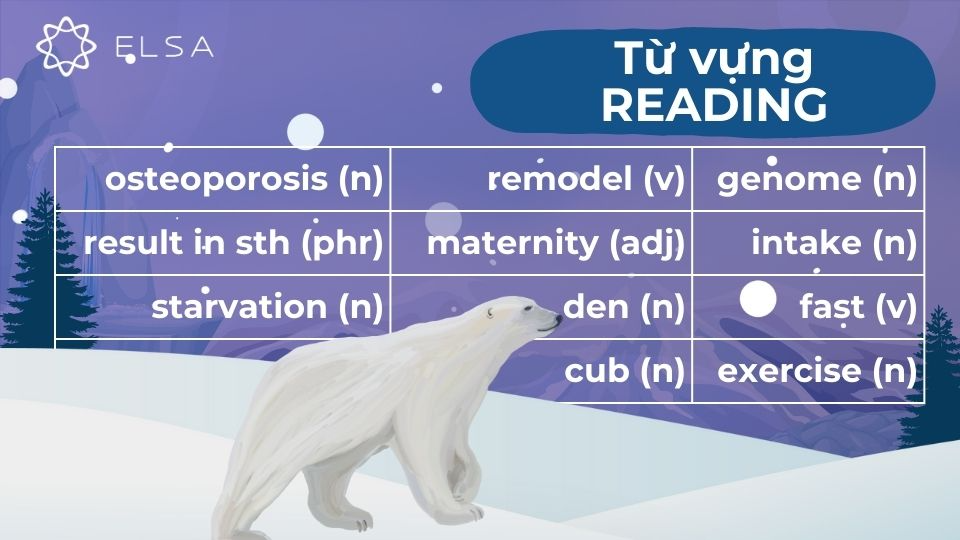
Dịch đoạn 4 bài Reading Why We Need to Protect Polar Bears:
| Tiếng Anh | Dịch tiếng Việt |
| Physiologists Alanda Lennox and Allen Goodship found an explanation for this paradox in 2008. They discovered that pregnant bears were able to increase the density of their bones before they started to build their dens. In addition, six months later, when they finally emerged from the den with their cubs, there was no evidence of significant loss of bone density. Hibernating brown bears do not have this capacity and must therefore resort to major bone reformation in the following spring. If the mechanism of bone remodelling in polar bears can be understood, many bedridden humans, and even astronauts, could potentially benefit. | Nhà sinh lý học Alanda Lennox and Allen Goodship đã tìm ra lời giải thích cho nghịch lý này vào năm 2008. Họ đã khám phá ra rằng những con gấu mang thai có khả năng làm tăng mật độ xương của chúng trước khi chúng bắt đầu xây dựng hang ổ. Thêm nữa, sáu tháng sau đó, khi mà cuối cùng chúng cũng chui lên khỏi hang cùng với đàn con của chúng, thì không hề có bằng chứng nào về sự mất mát đáng kể của mật độ xương. Những con gấu nâu ngủ đông không có khả năng này và do vậy buộc phải cải tạo xương chính trong mùa xuân tới. Nếu cơ chế của việc tái tạo xương ở gấu Bắc cực có thể hiểu được, nhiều người phải nằm liệt giường và thậm chí cả những phi hành gia, có khả năng sẽ được hưởng lợi. |
Từ vựng đoạn 4 bài Reading Why We Need to Protect Polar Bears:
| Từ vựng | Phiên âm | Dịch nghĩa |
| Paradox (n) | /ˈpærəˌdɒks/ | Nghịch lý |
| Emerge (v) | /ɪˈmɜːrdʒ/ | Nổi lên, chui ra, lộ diện ra, lòi ra, … |
| Hibernate (v) | /ˈhaɪbərˌneɪt/ | Ngủ đông |
| Resort to (phr v) | /rɪˈzɔːrt tuː/ | Đành phải làm gì đó mặc dù không muốn để đạt được thứ gì đó |
| Reformation (n) | /ˌrɛfərˈmeɪʃən/ | Sự cải tạo, cải tổ |
| Mechanism (n) | /ˈmɛkəˌnɪzəm/ | Một tập hợp vận hành cùng nhau, cơ cấu, cơ chế, thể chế |
| Bedridden (adj) | /ˈbɛdˌrɪdən/ | Nằm liệt giường do bệnh hoặc thương tật |
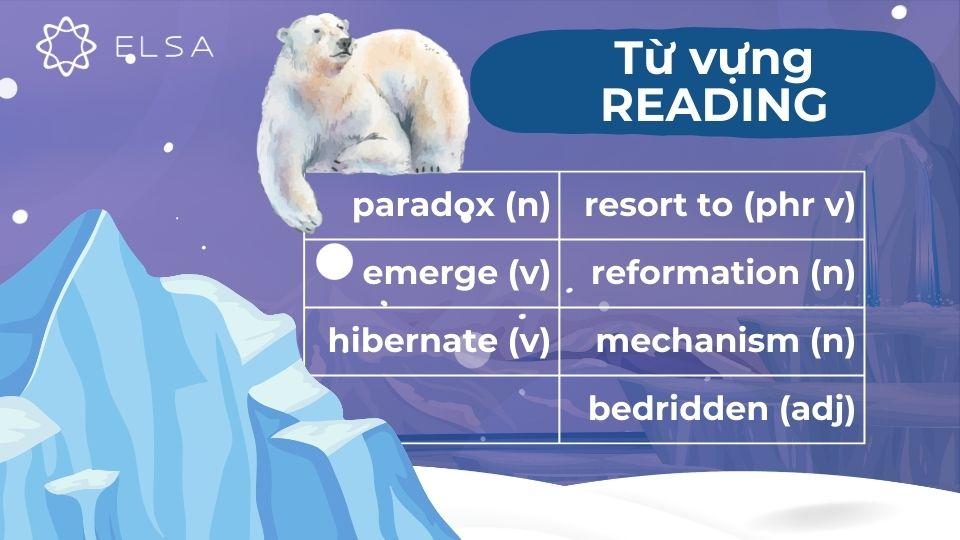
Dịch đoạn 5 bài Reading Why We Need to Protect Polar Bears:
| Tiếng Anh | Dịch tiếng Việt |
| The medical benefits of the polar bear for humanity certainly have their importance in our conservation efforts, but these should not be the only factors taken into consideration. We tend to want to protect animals we think are intelligent and possess emotions, such as elephants and primates. Bears, on the other hand, seem to be perceived as stupid and in many cases violent. And yet anecdotal evidence from the field challenges those assumptions, suggesting for example that polar bears have good problem-solving abilities. A male bear called GoGo in Tennoji Zoo, Osaka, has even been observed making use of a tool to manipulate his environment. The bear used a tree branch on multiple occasions to dislodge a piece of meat hung out of his reach. Problem-solving ability has also been witnessed in wild polar bears, although not as obviously as with GoGo. A calculated move by a male bear involved running and jumping onto barrels in an attempt to get to a photographer standing on a platform four metres high. | Những lợi ích về mặt y học của gấu Bắc cực cho loài người chắc chắn có tầm quan trọng của chúng trong những nỗ lực bảo tồn của chúng ta, nhưng những điều này không nên là những yếu tố duy nhất để chúng ta cân nhắc. Chúng ta có xu hướng mong muốn bảo vệ các loài động vật mà chúng ta nghĩ là thông minh và sở hữu những cảm xúc, như voi và các loài loài linh trưởng. Mặt khác những con gấu thì được cho là ngu xuẩn và hung dữ trong nhiều trường hợp. Mặc dù vậy bằng chứng mang tính giai thoại ở khu vực chứng sinh sống thách thức những giả định đó, cho thấy ví dụ như gấu Bắc Cực có những khả năng giải quyết vấn đề tốt. Một con gấu đực được gọi là GoGo ở vườn thú Tennoji, Osaka thậm chí được quan sát rằng đang sử dụng một công cụ để khéo léo kiểm soát môi trường của nó. Con gấu đã dùng một cành cây trong nhiều lần để đánh bật một miếng thịt treo ngoài tầm với của nó. Khả năng giải quyết vấn đề cũng được chứng kiến ở các con gấu bắc cực hoang dã, mặc dù không rõ ràng như với GoGo. Một sự di chuyển có tính toán bởi một con gấu đực trong việc chạy và nhảy lên các thùng trong một nỗ lực nhằm tiếp cận một nhiếp ảnh gia đang đứng trên một cái bục cao bốn mét. |
Từ vựng đoạn 5 bài Reading Why We Need to Protect Polar Bears:
| Từ vựng | Phiên âm | Dịch nghĩa |
| Conservation (n) | /ˌkɒnsərˈveɪʃən/ | Việc bảo tồn |
| Primate (n) | /ˈpraɪmeɪt/ | Động vật linh trưởng |
| Perceive (v) | /pərˈsiːv/ | Hiểu, nhận thức, nhận thấy, lĩnh hội |
| And yet (phr) | /ænd jɛt/ | Bất chấp những gì đã đề cập trước đó |
| Anecdotal (adj) | /ˌænɪkˈdoʊtəl/ | Không căn cứ vào thực tế hoặc sự nghiên cứu tỉ mỉ |
| The field (n) | /ðə fiːld/ | Nơi mà những công việc thực tế được triển khai |
| Assumption (n) | /əˈsʌmpʃən/ | Thứ mà bạn chấp nhận đó là đúng mà không thắc mắc hay cần có chứng cứ |
| Observe (v) | /əbˈzɜrv/ | Quan sát |
| Make use of (phr) | /meɪk juːs ɒv/ | Sử dụng cho một mục đích, tận dụng |
| Manipulate (v) | /məˈnɪpjəˌleɪt/ | Kiểm soát thứ hoặc ai đó cho lợi ích của mình, thường bằng mánh khóe |
| Dislodge (v) | /dɪsˈlɒdʒ/ | Đánh bật ra khỏi, đuổi ra khỏi |
| Witness (v) | /ˈwɪtnəs/ | Chứng kiến |
| Calculated (adj) | /ˈkælkjʊˌleɪtɪd/ | Sắp xếp hay có kế hoạch nhằm tạo ra một hiệu quả nào đó |
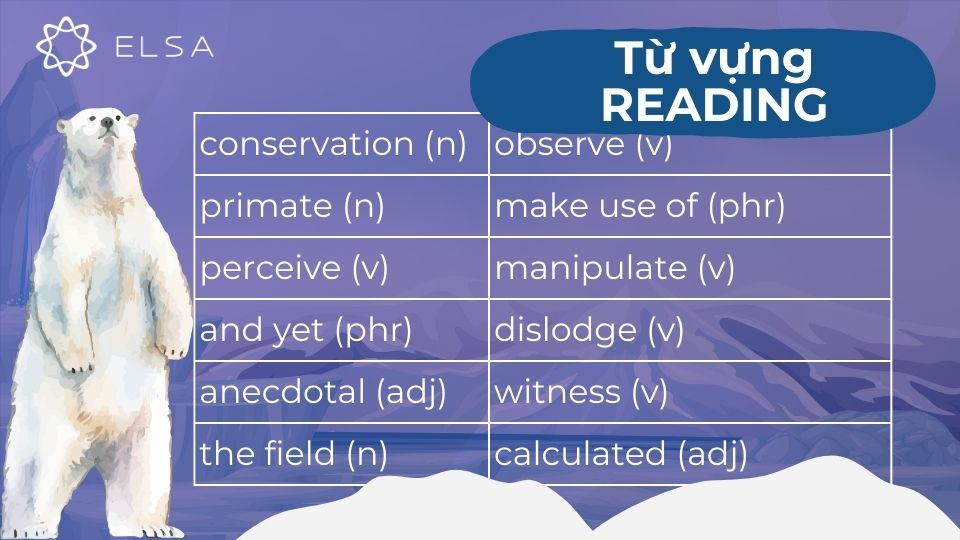
Dịch đoạn 6 bài Why We Need to Protect Polar Bears:
| Tiếng Anh | Dịch tiếng Việt |
| In other studies, such as one by Alison Ames in 2008, polar bears showed deliberate and focussed manipulation. For example, Ames observed bears putting objects in piles and then knocking them over in what appeared to be a game. The study demonstrates that bears are capable of agile and thought-out behaviours. These examples suggest bears have greater creativity and problem-solving abilities than previously thought. | Trong các nghiên cứu khác, như là nghiên cứu của Alison Ames vào 2008, gấu bắc cực đã thể hiện thao tác kiểm soát có chủ ý và tập trung. Ví dụ, Ames đã quan sát những con gấu đặt các vật lên thành các chồng và rồi xô đổ chúng như là một trò chơi. Nghiên cứu này cho thấy rằng loài gấu có khả năng chuyển động cơ thể nhanh nhẹn và những ứng xử có tính toán trước. Những ví dụ này nói lên rằng loài gấu có sự sáng tạo tốt hơn và những khả năng giải quyết vấn đề tốt hơn chúng ta đã nghĩ. |
Một số từ vựng đoạn 6 bài Why We Need to Protect Polar Bears:
| Từ vựng | Phiên âm | Dịch nghĩa |
| Deliberate (adj) | /dɪˈlɪbərɪt/ | Có chủ ý hoặc có kế hoạch trước |
| Knock over (phr) | /nɒk ˈoʊvər/ | Đánh đổ |
| Demonstrate (v) | /ˈdɛmənˌstreɪt/ | Chứng minh, cho thấy rõ |
| Agile (adj) | /ˈædʒaɪl/ | Có thể chuyển động cơ thể nhanh và dễ dàng |
| Thought-out (phr) | /θɔːt aʊt/ | Có chủ ý, có kế hoạch trước |
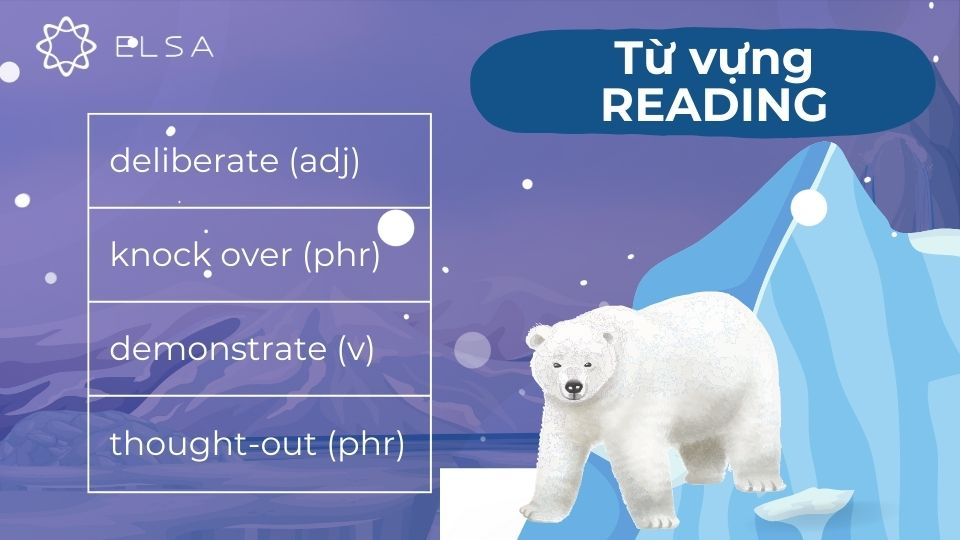
Dịch đoạn 7 bài Why We Need to Protect Polar Bears:
| Tiếng Anh | Dịch tiếng Việt |
| As for emotions, while the evidence is once again anecdotal, many bears have been seen to hit out at ice and snow – seemingly out of frustration – when they have just missed out on a kill. Moreover, polar bears can form unusual relationships with other species, including playing with the dogs used to pull sleds in the Arctic. Remarkably, one hand-raised polar bear called Agee has formed a close relationship with her owner Mark Dumas to the point where they even swim together. This is even more astonishing since polar bears are known to actively hunt humans in the wild. | Về cảm xúc, trong khi các bằng chứng một lần nữa chỉ là giai thoại, nhiều con gấu đã được nhìn thấy đánh vào băng và tuyết – dường như là do sự thất vọng – khi chúng vừa bỏ lỡ một con mồi. Hơn nữa, những con gấu Bắc cực có thể xây dựng những mối quan hệ lạ thường với các loài khác, bao gồm chơi với những con chó được dùng kéo xe trượt tuyết ở Bắc cực. Đáng chú ý, một con gấu Bắc cực được nuôi dưỡng từ nhỏ được gọi là Agee đã xây dựng nên một mối quan hệ thân thiết với chủ của nó Mark Dumas đến mức họ thậm chí bơi cùng nhau. Điều này thậm chí còn ngạc nhiên hơn bởi vì những con gấu Bắc cực được biết là tích cực tấn công con người ở nơi hoang dã. |
Từ vựng đoạn 7 bài Why We Need to Protect Polar Bears:
| Từ vựng | Phiên âm | Dịch nghĩa |
| Hit out (phr v) | /hɪt aʊt/ | Đánh ai đó bằng tay hoặc đồ vật |
| Frustration (n) | /frʌˈstreɪʃən/ | Thất vọng |
| Out of | /aʊt ʌv/ | Sử dụng để nói lên lý do tại sao ai đó làm việc gì |
| Miss out on (phr) | /mɪs aʊt ɒn/ | Bỏ lỡ cơ hội, thất bại |
| Kill (n) | /kɪl/ | Con mồi |
| Sled (n) | /slɛd/ | Xe trượt tuyết |
| Hand-raised (phr) | /hænd reɪzd/ | Nuôi dưỡng từ nhỏ bởi con người |
| Astonish (v) | /əˈstɒnɪʃ/ | Làm ngạc nhiên |
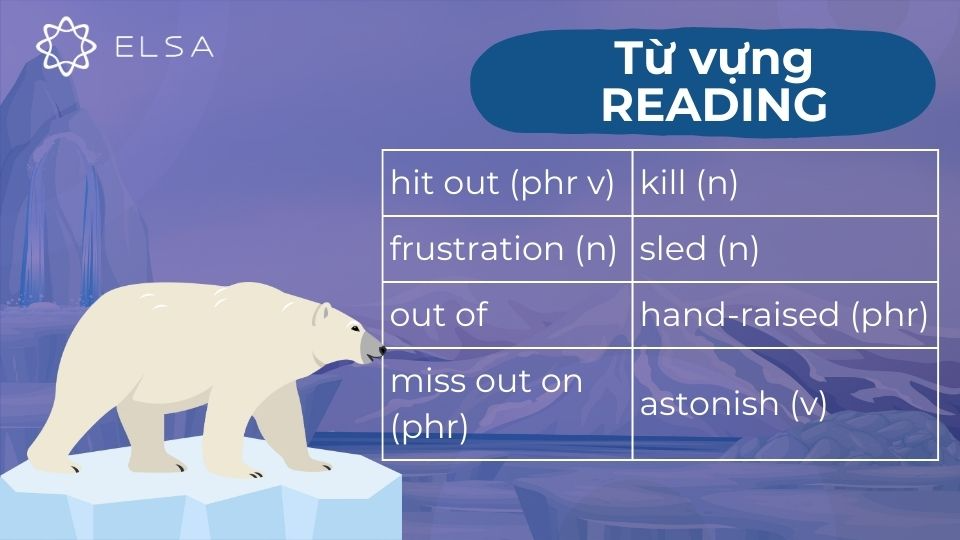
Dịch đoạn cuối bài Why We Need to Protect Polar Bears:
| Tiếng Anh | Dịch tiếng Việt |
| If climate change were to lead to their extinction, this would mean not only the loss of potential breakthroughs in human medicine, but more importantly, the disappearance of an intelligent, majestic animal. | Nếu thay đổi khí hậu dẫn đến sự tuyệt chủng của chúng, điều này có nghĩa không chỉ là sự mất mát của những tiềm năng quan trọng trong y học của loài người, mà quan trọng hơn, sự biến mất của một loài động vật oai vệ và thông minh. |
Từ vựng đoạn cuối bài Why We Need to Protect Polar Bears:
| Từ vựng | Phiên âm | Dịch nghĩa |
| Breakthrough (n) | /ˈbreɪkˌθruː/ | Một khám phá hay sự kiện quan trọng giúp cải thiện tình hình hay cung cấp câu trả lời cho một vấn đề |
| Majestic (adj) | /məˈdʒɛstɪk/ | Uy nghi, oai nghiêm, oai vệ, đường bệ |
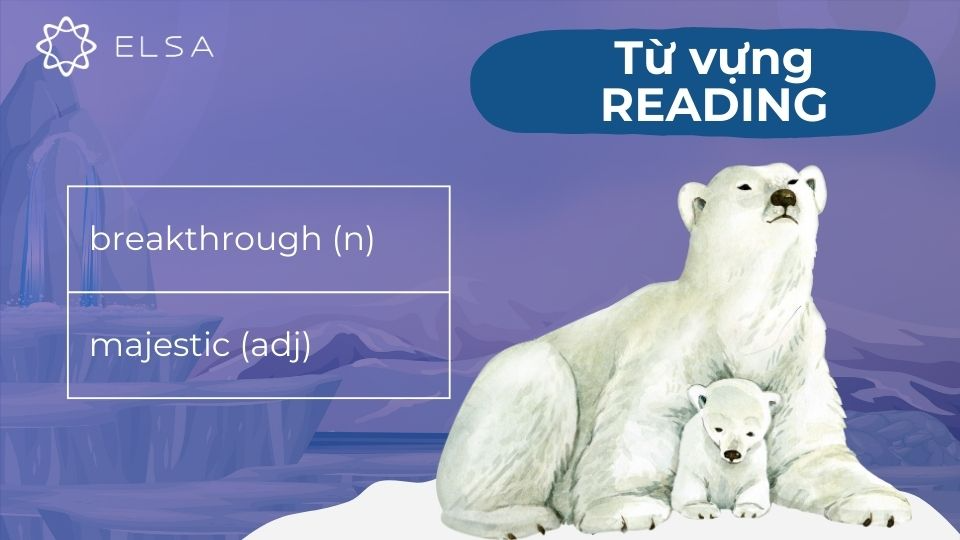
Câu hỏi Reading Why We Need to Protect Polar Bears
Trong phần này, chúng ta sẽ khám phá các câu hỏi của bài Reading Why We Need to Protect Polar Bears.
Questions 1-7
Do the following statements agree with the information given in the Reading Passage?
In following statements below, choose the correct answer: TRUE, FALSE, or NOT GIVEN.
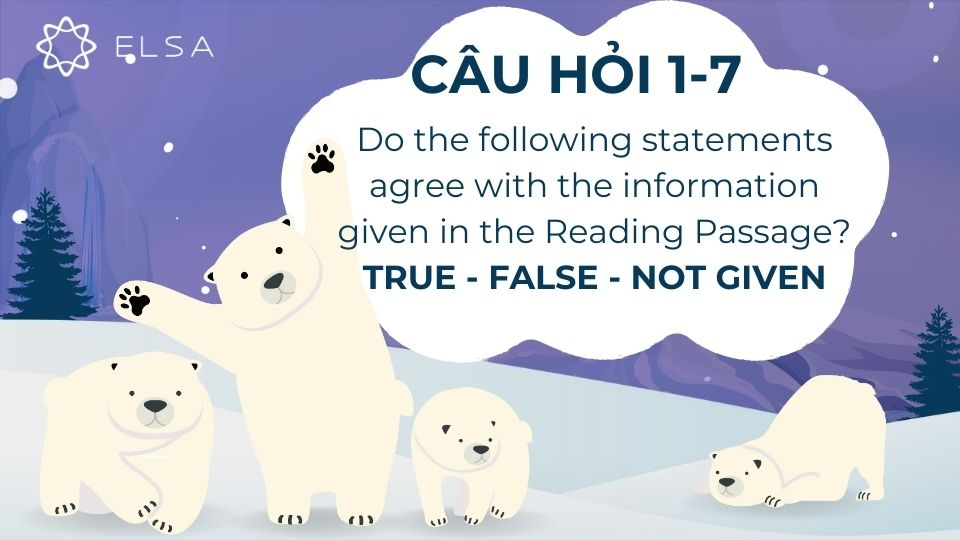
TRUE if the statement agrees with the information
FALSE if the statement contradicts the information
NOT GIVEN if it is impossible to say what the writer thinks about this
1. ……………Polar bears suffer from various health problems due to the build-up of fat under their skin.
2. …………… The study done by Liu and his colleagues compared different groups of polar bears.
3. …………… Liu and colleagues were the first researchers to compare polar bears and brown bears genetically.
4. …………… Polar bears are able to control their levels of ‘bad’ cholesterol by genetic means.
5. …………… Female polar bears are able to survive for about six months without food.
6. …………… It was found that the bones of female polar bears were very weak when they came out of their dens in spring.
7. …………… The polar bear’s mechanism for increasing bone density could also be used by people one day.
Questions 8-13
Complete the table below.
Choose ONE WORD ONLY from the passage for each answer.

Reasons why polar bears should be protected
People think of bears as unintelligent and 8 _______.
However, this may not be correct. For example:
- In Tennoji Zoo, a bear has been seen using a branch as a 9 _______. This allowed him to knock down some 10 _______.
- A wild polar bear worked out a method of reaching a platform where a 11 _______ was located.
- Polar bears have displayed behavior such as conscious manipulation of objects and activity similar to a 12 _______.
Bears may also display emotions. For example:
- They may make movements suggesting 13 _______ if disappointed when hunting.
- They may form relationships with other species.
Đáp án và giải thích Reading “Why We Need to Protect Polar Bears”
Trong phần này, chúng ta sẽ đi qua đáp án của bài đọc Why We Need to Protect Polar Bears trong phần Reading của IELTS. Mỗi câu hỏi đều có đáp án chi tiết, kèm theo vị trí và từ khóa giúp bạn dễ dàng xác định thông tin trong bài. Phần giải thích sẽ chỉ ra lý do vì sao đáp án được lựa chọn là TRUE, FALSE, hoặc NOT GIVEN, nhằm giúp bạn hiểu rõ và tránh nhầm lẫn khi làm bài thi Reading.
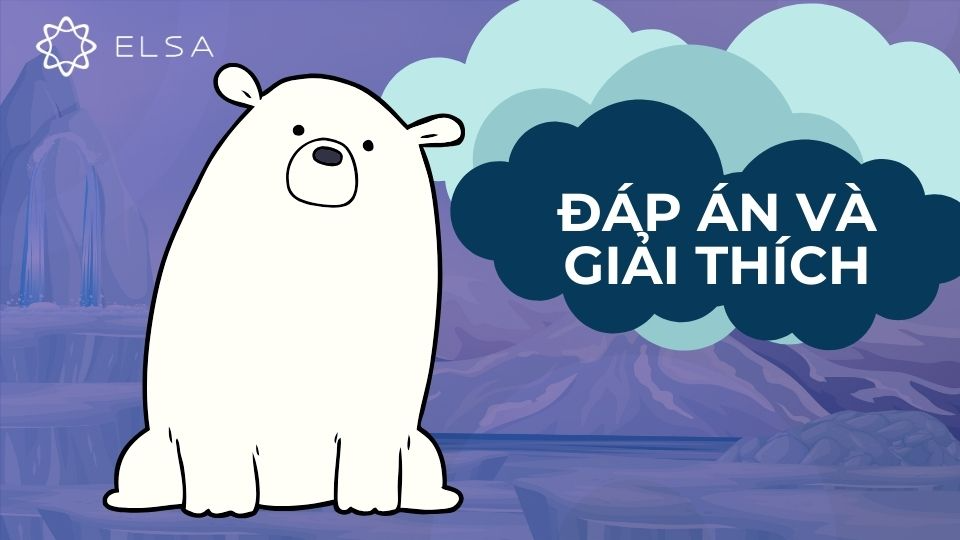
Questions 1-7:
| Câu hỏi | Đáp án | Vị trí | Từ khóa | Giải thích |
| Câu 1 | FALSE | Đoạn 1, câu 3-5 | “polar bears”, “health problems”, “fat under their skin” | Đoạn 1, câu 3-5 chỉ ra rằng gấu bắc cực có lớp mỡ dày tới 11 cm dưới da, nhưng chúng không gặp phải các vấn đề sức khỏe như con người. Chi tiết này trái ngược với thông tin trong câu hỏi 1, vì gấu bắc cực không chịu đựng những vấn đề về sức khỏe do lớp mỡ dày dưới da. |
| Câu 2 | FALSE | Đoạn 2, câu 1-2 | “study by Liu and colleagues”, “different groups of polar bears” | Nghiên cứu của Liu và các đồng nghiệp so sánh cấu trúc gen của gấu bắc cực với gấu nâu, không phải so sánh các nhóm gấu bắc cực khác nhau. Điều này trái ngược với thông tin trong câu hỏi 2. |
| Câu 3 | Not Given | Đoạn 2, câu 1-2 | “first researchers”, “compare polar bears and brown bears” | Bài đọc không xác nhận liệu Liu và các đồng nghiệp có phải là những nhà nghiên cứu đầu tiên so sánh gấu bắc cực và gấu nâu hay không. Do đó, thông tin này không được đề cập. |
| Câu 4 | TRUE | Đoạn 2, câu 4 | “control levels of ‘bad’ cholesterol”, “APOB gene” | Đoạn 2, câu 4 cho thấy gấu bắc cực có gen APOB, giúp giảm mức độ lipoprotein mật độ thấp (LDL), tức là cholesterol xấu. Điều này khẳng định rằng gấu bắc cực có thể kiểm soát cholesterol xấu bằng các biện pháp di truyền. |
| Câu 5 | TRUE | Đoạn 3, câu 4-6 | “female polar bears”, “six months without food” | Đoạn 3, câu 4-6 chỉ ra rằng gấu bắc cực cái có thể sống sót trong khoảng sáu tháng mà không cần thức ăn trong quá trình mang thai. Điều này khẳng định thông tin trong câu hỏi 5. |
| Câu 6 | FALSE | Đoạn 3, 2 câu cuối | “bones of female polar bears”, “very weak” | Đoạn 3, 2 câu cuối cho biết rằng xương của gấu bắc cực cái vẫn khỏe và đặc, ngay cả sau khi trải qua thời gian nhịn ăn. Điều này trái ngược với thông tin trong câu hỏi 6. |
| Câu 7 | TRUE | Đoạn 4, câu cuối | “mechanism for increasing bone density”, “benefit people” | Đoạn 4, câu cuối chỉ ra rằng nếu cơ chế tái tạo xương ở gấu bắc cực được hiểu, nhiều người, bao gồm cả phi hành gia, có thể hưởng lợi từ nó. Điều này khẳng định thông tin trong câu hỏi 7. |
Questions 8 -13:
| Câu hỏi | Đáp án | Từ khóa | Giải thích |
| Câu 8 | violent | “unintelligent and violent” | Bài đọc cho biết rằng gấu thường được coi là “ngu ngốc và bạo lực,” phản ánh quan điểm sai lệch về chúng. |
| Câu 9 | tool | “using a branch as a tool” | Một con gấu ở vườn thú Tennoji đã được quan sát sử dụng một cành cây như một “công cụ” để thao túng môi trường của nó. |
| Câu 10 | meat | “knock down some meat” | Con gấu đã dùng cành cây để đánh bật một miếng “thịt” nằm ngoài tầm với của nó. |
| Câu 11 | photographer | “where a photographer was located” | Một con gấu đã tìm ra cách để tiếp cận một “nhiếp ảnh gia” đứng trên một bục cao bốn mét. |
| Câu 12 | game | “activity similar to a game” | Bài đọc mô tả rằng gấu bắc cực thể hiện hành vi thao túng có chủ đích và tập trung, ví dụ như xếp các đồ vật thành đống và sau đó xô ngã chúng trong một “trò chơi.” |
| Câu 13 | frustration | “movements suggesting frustration” | Nhiều con gấu đã được thấy có những động tác thể hiện cảm xúc “tức giận” khi chúng bỏ lỡ một con mồi. |
>> Xem thêm:
- Giải đề IELTS Cambridge: Why companies should welcome disorder
- Cách làm đề Advantage and disadvantage trong IELTS Writing Task 2
- Hướng dẫn giải đề thi IELTS Reading: How to make wise decisions
Với những hướng dẫn chi tiết và phân tích trong bài Why We Need to Protect Polar Bears, hy vọng bạn sẽ tự tin hơn khi làm phần thi IELTS. Để có một kỳ thi thành công rực rỡ cũng như đạt mức điểm mong muốn, hãy luyện thi IELTS thường xuyên cùng các Khóa học luyện thi tiếng Anh của ELSA Speak và tham khảo ngay các bài viết ở danh mục luyện thi IELTS để có thêm kiến thức nhé!để cải thiện kỹ năng hằng ngày nhé!
 15/12/2024 | Admin
15/12/2024 | Admin











